
Circuit Description
The brake switch indicates brake pedal status to the powertrain control module (PCM). The brake switch is a normally-closed switch that supplies battery voltage on the torque converter clutch (TCC) brake switch signal circuit to the PCM. Applying the brake pedal opens the switch, interrupting voltage to the PCM. When the brake pedal is released, the PCM receives a constant voltage signal. If the PCM receives a zero voltage signal at the brake switch input, and the TCC is engaged, the PCM de-energizes the TCC solenoid valve. The PCM disregards the brake switch input for TCC scheduling if there is a brake switch circuit fault.
When the PCM detects a closed brake switch circuit, 12 volts, high input, during decelerations, then DTC P0724 sets. DTC P0724 is a type C DTC.
DTC Descriptor
This diagnostic procedure supports the following DTC:
DTC P0724 TCC Brake Switch Circuit High Voltage
Conditions for Running the DTC
| • | No vehicle speed sensor (VSS) DTCs P0502 or P0503. |
| • | The engine is running greater than 5 seconds. |
Conditions for Setting the DTC
The PCM detects a closed TCC brake switch circuit, 12 volts, without changing for 2 seconds and the following events occur 8 times:
- The vehicle speed is greater than 32 km/h (20 mph) for 7 seconds.
- The vehicle speed is between 8-32 km/h (5-20 mph) for 3 seconds.
- The vehicle speed is less than 8 km/h (5 mph).
Action Taken When the DTC Sets
| • | The PCM does not illuminate the malfunction indicator lamp (MIL). |
| • | The PCM records the operating conditions when the Conditions for Setting the DTC are met. The PCM stores this information as Failure Records. |
| • | The PCM stores DTC P0724 in PCM history. |
Conditions for Clearing the DTC
| • | A scan tool can clear the DTC. |
| • | The PCM clears the DTC from PCM history if the vehicle completes 40 warm-up cycles without a non-emission related diagnostic fault occurring. |
| • | The PCM cancels the DTC default actions when the fault no longer exists and the DTC passes. |
Diagnostic Aids
| • | Inspect for ABS DTCs. A faulty ABS condition may contribute to setting DTC P0724. |
| • | It may be necessary to also clear this DTC from the engine control module (ECM). |
Test Description
The number below refers to the step number on the diagnostic table.
Step | Action | Values | Yes | No |
|---|---|---|---|---|
1 | Did you perform the Diagnostic System Check - Vehicle? | -- | Go to Step 2 | |
Important: Before clearing the DTC, use the scan tool in order to record the Failure Records. Using the Clear Info function erases the Failure Records from the PCM. Caution: Refer to SIR Caution in the Preface section. Did the TCC Brake Switch status on the scan tool change from Closed to Open? | -- | Go to Step 3 | Go to Step 4 | |
3 | Replace the brake/cruise release switch. Refer to Stop Lamp Switch Replacement . Did you complete the replacement? | -- | Go to Step 6 | -- |
4 |
Important: The condition that affects this circuit may exist in other connecting branches of the circuit. Refer to Power Distribution Schematics for complete circuit distribution. Test the signal circuit of the brake/cruise release switch for a short to voltage. Refer to Testing for a Short to Voltage and Wiring Repairs . Did you find and correct the condition? | -- | Go to Step 6 | Go to Step 5 |
5 | Replace the PCM. Refer to Control Module References . Did you complete the replacement? | -- | Go to Step 6 | -- |
6 | Perform the following procedure in order to verify the repair:
Has the test run and passed? | -- | Go to Step 7 | Go to Step 2 |
7 | With the scan tool, observe the stored information, capture info, and DTC Info. Does the scan tool display any DTCs that you have not diagnosed? | -- | System OK |
